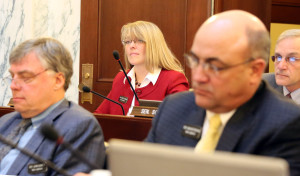Legislative budget-writers approved a 6.8 percent increase in public school funding Monday — but are taking a wait-and-see approach to some unsettled policy initiatives.

As reported Thursday by Idaho Education News, lawmakers are holding off on four significant policy initiatives that have yet to pass the Legislature. Those initiatives include a re-written literacy proposal that could cost up to $10.7 million, but has yet to be addressed in the Senate.
If those policy bills pass, budget-writers have said they will provide separate funding through so-called trailer bills that would be drafted and voted upon later this year.
“Hopefully we will get some combination of those requests that will get us up to at least a 7.4 percent increase,” said Rep. Wendy Horman, R-Idaho Falls, who helped write the school budget.
A 7.4 percent increase would mirror the budget boost passed in 2015. Public schools would account for about 48 percent of all state general fund spending.
As things stand now, the Joint Finance-Appropriations Committee voted to increase public school general fund spending by $100.3 million, a 6.8 percent increase. This 6.8 increase would bring total general fund spending on education to nearly $1.6 billion.
“I’m very excited — this is a great day for education,” Superintendent of Public Instruction Sherri Ybarra said after the hearing. “If they’re going to put more money into education, of course, I am going to be the champion for that.”
Under the budget set Monday, teachers can expect another raise next year. JFAC’s budget would increase teacher pay by $41.5 million by paying for the second year of the career ladder salary law. The budget also moves pupil-services staffers onto the salary ladder.
Legislators also voted to spend $27.3 million to reverse recession-era cuts to discretionary funding sent to local school districts — a pot of money sometimes called operations funding.
Discretionary spending would increase to $25,696 per classroom, a number last reached in 2008-09. Current per-classroom spending levels are $23,868.
JFAC Democrats tried unsuccessfully to boost operational spending to $26,032 per classroom, at an additional cost of $5 million. The effort failed along party lines and the committee then unanimously backed the increase to $25,696.
Boosting teacher pay and restoring operational funding were among Horman’s top priorities.
“I was thrilled to get budgets out with unanimous support for the career ladder funding and restoring our discretionary dollars,” Horman said. “That sends a great message out to our educators in schools that we value them.”
Lawmakers did not fund Ybarra’s proposed $300,000 rural schools center. After the hearing, Ybarra said she wanted to focus on what schools got under the budget, not what they didn’t get.
“We still have some work to do,” Ybarra told reporters. “Hopefully, if it doesn’t happen this year, we will try again next year.”
Even if lawmakers bolster the school budget in the coming weeks, the spending plans are likely to fall short of early-session budget recommendations.
In his State of the State address, Gov. Butch Otter proposed a 7.9 percent increase. Ybarra called for a 7.6 percent increase.
One big reason the school budget will fall short of Otter’s recommendations is because the governor underestimated student enrollment growth that JFAC is paying for. Another reason is a dip in state revenues, which are nearly $14 million below initial projections.
Budget highlights include:
- $5 million in new, ongoing funding for classroom technology.
- $3 million in increased funding for educators’ professional development training, bringing the total to $16.4 million.
- 3 percent raises for school administrators and classified staff members not paid under the career ladder salary law.
- $16.6 million in ongoing funding for salary awards called teacher leadership premiums.
- $6.7 million for remediation and limited English proficiency.
- $6 million in ongoing funding to pay for advanced opportunities programs that allow students to earn college credits while they attend high school.
- $3 million for local school districts or charter schools to purchase instructional management systems as the state shuts down its Schoolnet system.
- $2.1 million for WiFi services for local districts.
As with previous years, the school budget was broken into seven different pieces. JFAC passed each bill unanimously.
The seven bills must pass the House and Senate before going to Otter’s desk.
Further reading: Idaho Ed News reporter Kevin Richert offers an analysis of the unsettled policy issues that could wind up being funded in trailer bills.
